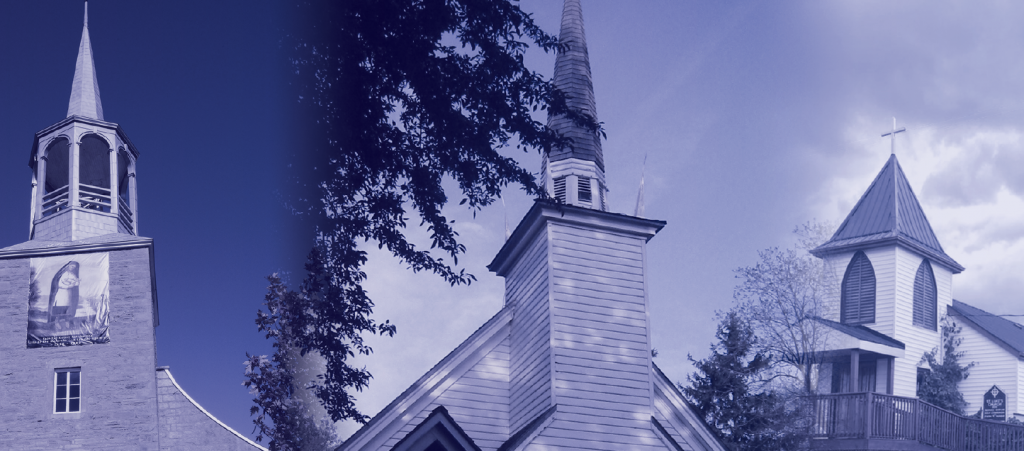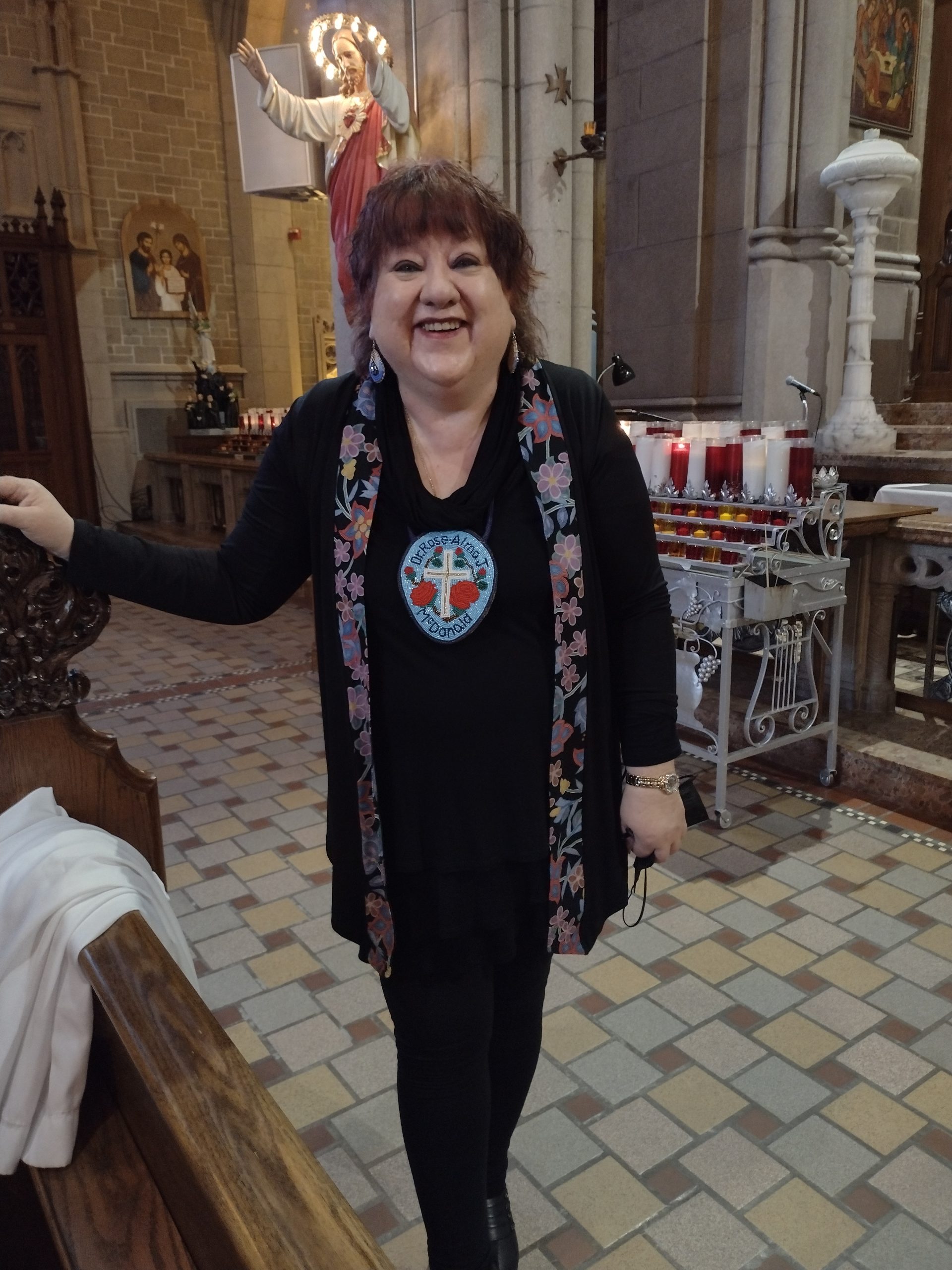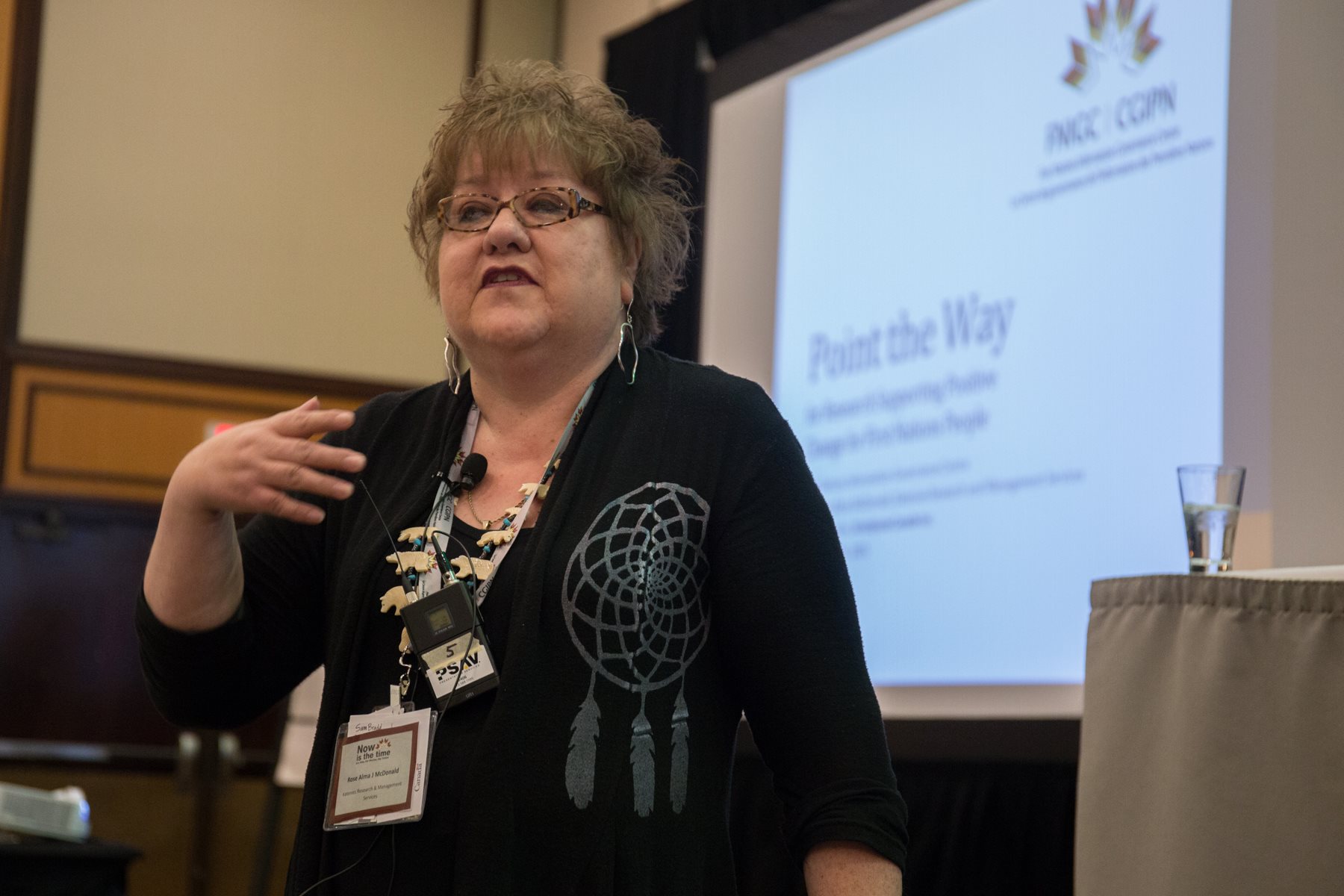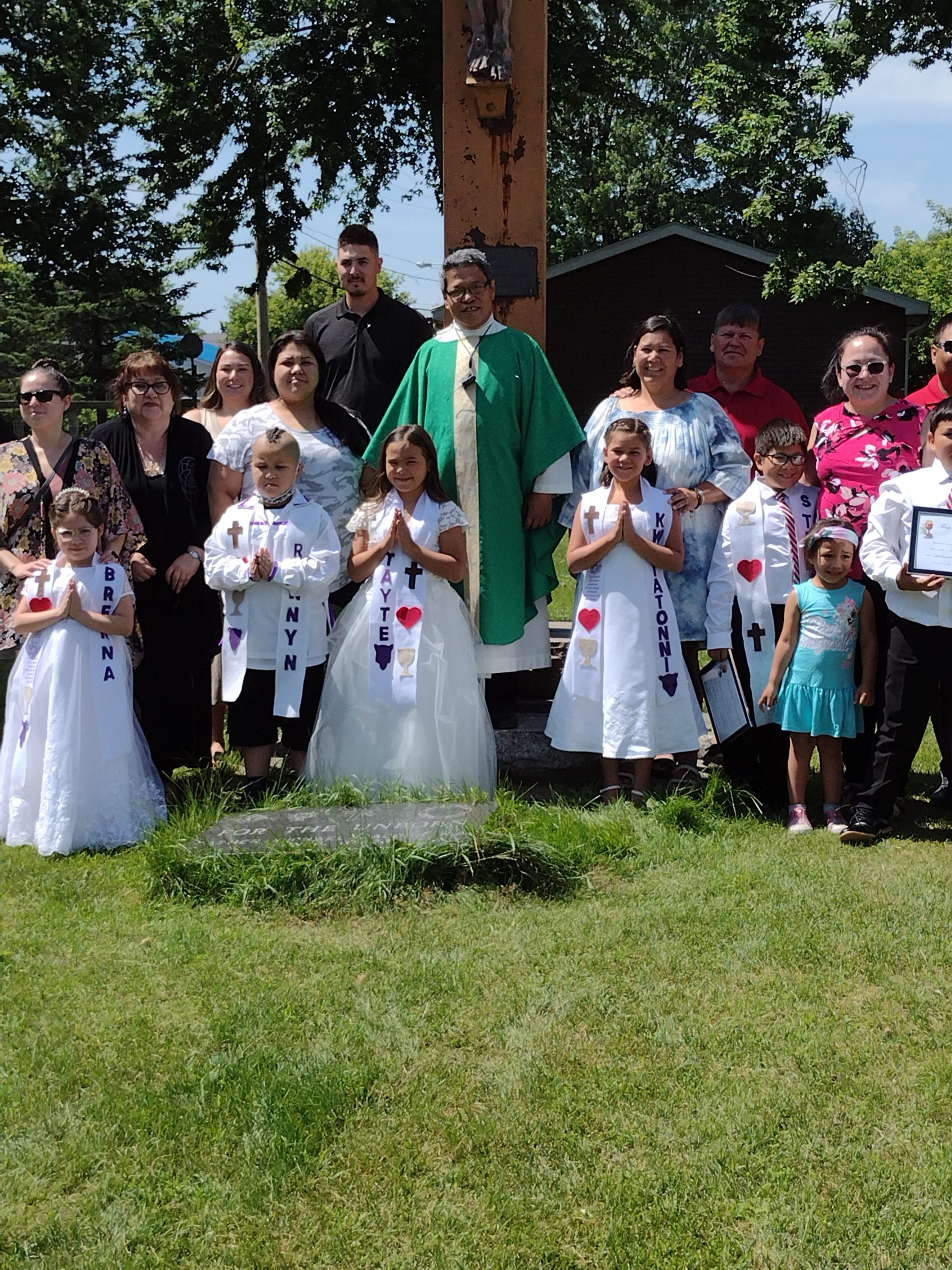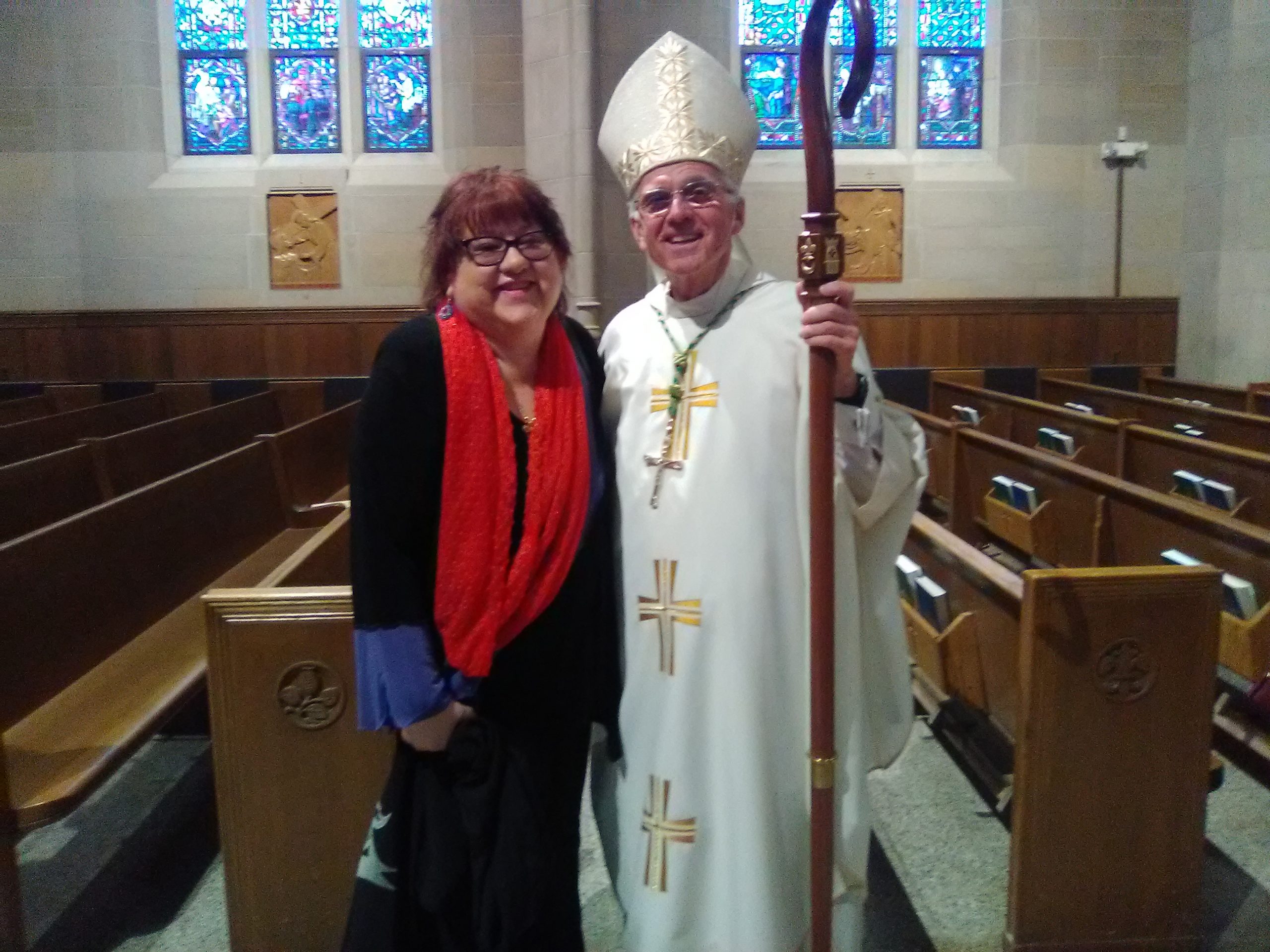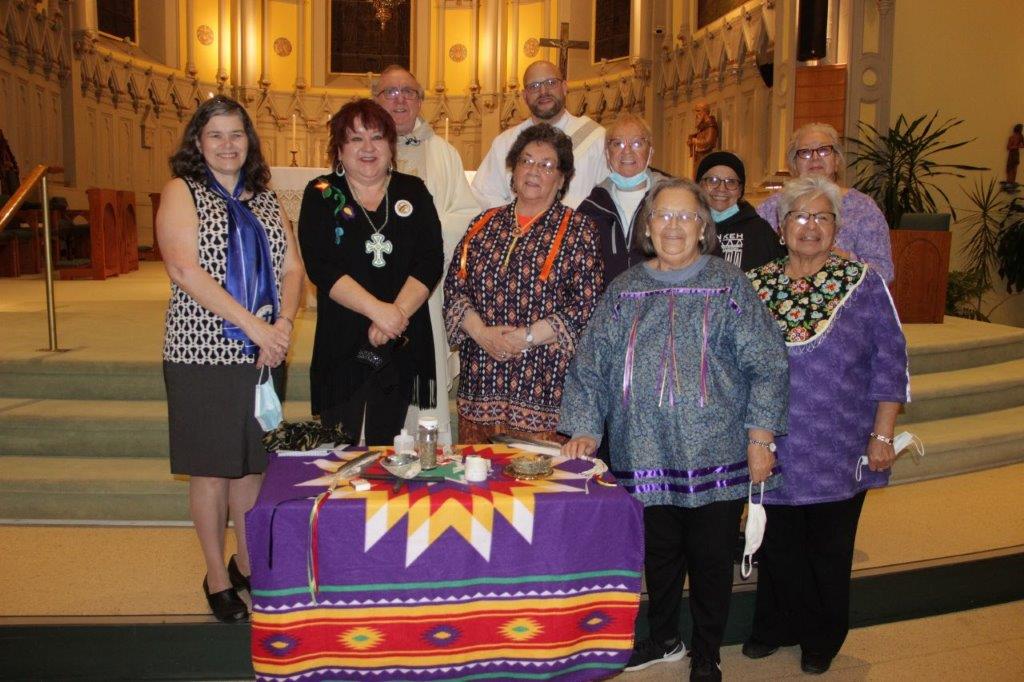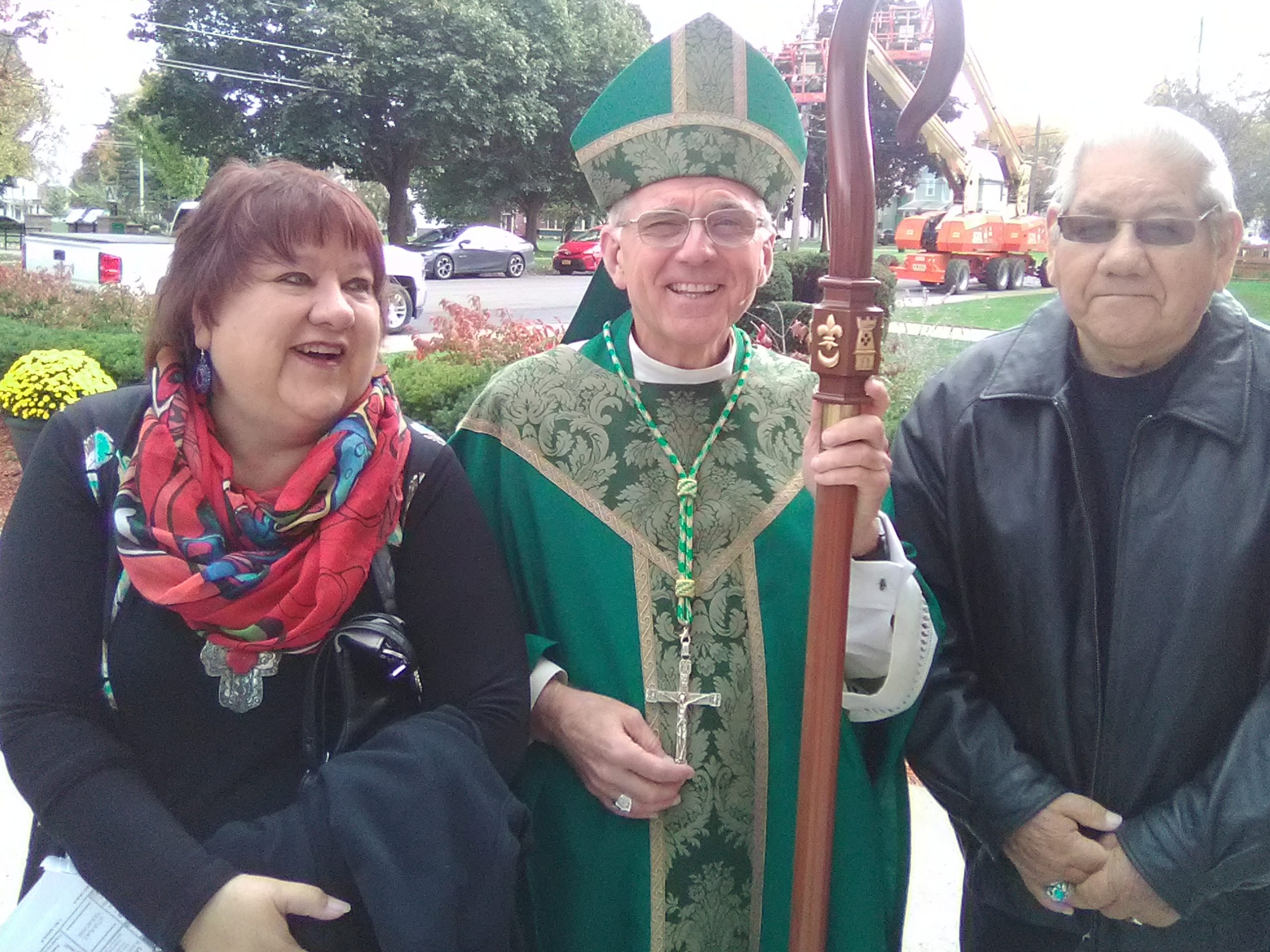Introduction
Indigenous Voices of Faith is a series of interviews conducted by Cardus in the fall of 2022, in which we asked twelve Indigenous people in Canada to tell us about their religious faith and experiences. Since 47 percent of Indigenous people in Canada identify as Christians, Christian voices are the primary but not sole focus of this interview series. The purpose of this project is to affirm and to shed light on the religious freedom of Indigenous peoples to hold the beliefs and engage in the practices that they choose and to contextualize their faith within their own cultures.
Father Deacon Andrew Bennett, program director for Cardus Faith Communities, interviewed Dr. Rose-Alma McDonald in Saint Regis, Quebec/Akwesasne Mohawk Territory on November 28, 2022. The interview has been edited for clarity.
Interview Transcript
Fr. Dcn. Andrew Bennett: Rose-Alma, it’s wonderful to have you with me this morning, and thank you very much for participating in this project.
Dr. Rose-Alma McDonald: I’m very honoured. Thank you for thinking of me.
Fr. Dcn. Andrew: Tell me about your own Indigenous background and a little bit about your work and your family.
Dr. Rose-Alma McDonald: Well, I’m Mohawk from Akwesasne. We’re the only First Nation in North America that borders New York, Ontario, Quebec, Canada, and the US. I kind of have a foot in both. I have a home in New York State on the reservation, and I also have one in Quebec on reserve. I was born to an Akwesasronon family—my mom and dad were both Mohawk, but my grandmother on my mother’s side was a Bourget from Valleyfield, Quebec. She was a sister to Monsignor Joseph Bourget, who was the pastor here for about forty-two years. She came to help him at the rectory and met my grandfather Lawrence Hopps and married him. She only spoke French, and he only spoke Mohawk. So I come from a family that’s very religious, in the sense that Monsignor Bourget was, “Uncle Priest.” I don’t remember him, because he was gone by the time I was born. But I know a lot about him, because of the way that our family lived.
I grew up on the reserve, and I’ve lived here all my life. I’m sixty-eight. So growing up, there were always nuns and priests at our house. My mother was in the Altar Rosary Society and the Mohawk Choir. My father was the president of the St. John the Baptist Society, and he was an usher, bell-ringer and did collections for the church. My whole life I was a cradle Catholic.
I have beautiful pictures of my mom with me as a little girl. We always had a beautiful nativity scene at Christmas time, and I have pictures of her with me in front of the nativity at church. As soon as I turned eighteen, I went to university, for fifteen years. I have a bachelor’s degree in criminal justice from Oswego State University, and then from St. Lawrence University, which is a beautiful private university, I got my master’s degree in education (EdM). Then I also got an advanced master’s degree. I went on to Pennsylvania State University. They had a Native American leadership training program, and I went there and got a Doctor of Education (EdD) in educational administration.
Fr. Dcn. Andrew: Fantastic.
Dr. Rose-Alma McDonald: I’m a certified school-district administrator and a permanently certified teacher. I have all this academic background, but I only just came back to the church five years ago. I left the church for twenty years. Part of my leaving was because of my family.
Our church was built in 1752, so it’s very old. Our community has always been very Catholic. We’re a community of fourteen thousand people, Mohawks, and so I would say the majority are Catholic, especially during the time of Monsignor Bourget. They were very strict in those days. Everybody got baptized, we have church records going back to 1752. And so, if you look, all of our people were baptized, but now there’s this evolution of Long House, traditional belief. It is a spiritual way of living that’s based on Mother Earth. They have ceremonies at certain times of the year.
When I went to university, because I’m Catholic I went to the SUNY Newman Center and I connected with the priest there. He was young. This was in the seventies, and they were introducing guitar music in the church. It was a young church, “young” meaning the parishioners were students like myself. It was relevant. I had my own peers. Everything was more geared to young people and students. Whereas here, the Masses were still in Latin, way back when, and the priests were very strict, like the Orthodox Church.
When I married an Orthodox, what I found out, is that they are now today what we were, back in the fifties, sixties, seventies. I got married, and then I got divorced after 13 years. Well, when I got counselling from the priest the first thing the priest said to me was, “It’s your fault. You’re travelling all the time, and you’re working all the time, and you’re not paying attention to [your] husband.” Everything was wrong with me because of not being the conventional type of female. At that point I said, “This church has no relevance to me.” The other big criticism that I had is that we did have a Mohawk priest when I was growing up in the fifties and sixties, his name was Father Jacobs. He was also very strict, but at least he was Mohawk. We could relate to him, and he understood our culture. After him, we had this other priest, his name was Father Arsenault, and he was a young, funky kind of priest, and we all loved him. I used to go to CYO. You know what CYO is?
Fr. Dcn. Andrew: Catholic Youth?
Dr. Rose-Alma McDonald: Yes, I used to go to the Catholic Youth Organization. After Father Arsenault left, we got a string of older, non-Indigenous priests, very old fashioned, very conservative, who didn’t want to acknowledge our culture in the church. I think that was my other issue. We did have the Mohawk choir. My mother was in the Mohawk choir. So we did have that, but the priests didn’t integrate the culture in the Masses. I mentioned St. Kateri Tekakwitha to you. We have two feasts for her annually. One is, in April when she died, and then October is when she was canonized as a saint. So, we celebrate her twice.
I’ve been back to the church for about five years, and they do smudging in the church now, they do the four directions, and they have reintroduced a more regular Mohawk Choir. Many of the prayers in the Mass are in Mohawk. When we pray the “Our Father,” we say it in Mohawk, we also sing it in Mohawk.
Fr. Dcn. Andrew: Rose-Alma, tell me a little bit more about what it was that brought you back. What brought you back to the faith? And maybe say a little bit about that integration you just referenced. How is it important to have that integration? Because there are a lot of people that would say that you can’t be authentically First Nations or authentically Mohawk if you’re Christian. Give me your thoughts on that as well. But first tell me a little bit what brought you back.
Dr. Rose-Alma McDonald: Well, like I said, I didn’t want any part of this church, and to say it bluntly, it was just too white for me. I still have issues with that, because as a woman in the church, a woman could never be a deacon. I am a lay minister, Eucharistic minister, a sacristan, an altar server. I mean, when I came back, I shocked the heck out of my whole family. I went from one extreme to the other. Now I love the church and I can’t live without it.
What happened was my father died. He was one of the ones that was pushing me hard, and my brothers were still pushing me to go to church. Then a friend of mine, an elder, died, and her daughter reached out to me. I went to the wake, and she asked me as I was going out the door, “Can you do the eulogy for my mom?” She said, “My mom loved you, and she would want you to do this for her.”
The night before the funeral, I sat down with her and developed the eulogy and went to the church the next day for the funeral. When I went, I saw this new priest, he’s been here ten years now, named Father Jerome Pastores. He’s Filipino, he’s young, and he’s Indigenous. After the funeral he reached out to me and came over for coffee one day and said, “How come you don’t come to church?” And I said, “Well, do you really want to know?” It just wasn’t relevant to me. So little by little he coaxed me into coming back to church. I started to go to church, but not every week.
When I went back to church, everybody said, “Welcome home, you’re back.” One of the elders, when we were leaving church one Sunday, said to me, “It’s so nice to see you back at church, Dolly. You can come to church every week you know, it’s only fifty-two times a year. You can do that.” I never forgot that, because when you did the math, it’s true, “OK, well, that’s not so bad.”
Anyways, so the priest, Father Pastores, once he got me going to church a little more regularly, he said, “You have a nice smile. How about if you be a greeter for the church, because you’ve got a big smile and people love you,” so I said, “OK.” That I could agree to, because all I had to do was stand at the door and say “Welcome.” It changed the culture of our church once we started having a greeter, because the minute they came around the corner in the door, their face lit right up. “Hi, Dolly,” and then hug, hug. They felt so welcomed to the church. They were so happy when they came in the door to come to church. When they’d leave, I’d be at the door saying goodbye to them.
Father Jerome convinced me to be the greeter. Then he convinced me to be an altar server for funerals. Then he convinced me to be a Eucharistic minister. Then he taught me how to be a sacristan. And then, well, just about everything that you do in a church, I was doing it, and loving it because I realized, “Oh, this is what I was born for.” I had been raised, and I had been groomed to do what I do now.
Fr. Dcn. Andrew: What does it mean to you?
Dr. Rose-Alma McDonald: Well, I was just going to say I’m starting to get emotional, because he also convinced me to be the parish secretary for two years. I did the work of seven people. I did the finances, and I was the sacristan, all of it, plus the parish secretary. Oh, and I do the bulletin.
Fr. Dcn. Andrew: Ha ha! I understand well.
Dr. Rose-Alma McDonald: Then I started realizing that there’s a lot of politics in the church. It tested my faith. But I had started to relearn what I was groomed for. Like right now, Advent is my favourite, time of the year, with the Advent wreath and all the preparation for Christmas, all the religious pieces of it, and the Midnight Mass. And then there’s Easter time, with the sunrise Mass.
Fr. Dcn. Andrew: Is that the Easter Vigil?
Dr. Rose-Alma McDonald: I would be there, altar serving with Father at six in the morning.
So, I’ve learned some lessons in terms of my faith. And then when Kamloops happened, I just couldn’t cope with it, because in my academic training I had written papers about residential schools and their impact. Then all the people that had issues with the Catholic church emerged, which are a lot now. We have a congregation of maybe five hundred people, but we’re a community of fourteen thousand. When I was growing up, the church was packed every Sunday. So the residential schools grave findings kind of shook everybody’s world, not just my world. I was hurt. How could these nuns and priests do those things, that were very well documented, to our Indigenous children? It tested my faith again. I keep getting these tests of: why am I Catholic? And at that time there was piles of shoes in front of the church, and orange paint on the pavement in front of the church, and just a lot of resentment around the country. We went to an event at the diocese, and there was an Akwesasne elder there with us. We spoke about the residential schools with the bishop, and the elder said to him that “The church is an institution. The universal church is an institution. It’s God, it’s us as the church. But the people that did these things were humans. They weren’t gods. They were human beings who have flaws just like every other human being.” The elder said she was able to separate one from the other. “This is my church that I love. This is my God that I love. I can still be a Catholic.” So, I’m finding because of Kamloops that clergy are not perfect.
So the residential schools grave findings kind of shook everybody’s world, not just my world. I was hurt. How could these nuns and priests do those things, that were very well documented, to our Indigenous children? It tested my faith again.
Fr. Dcn. Andrew: No, we are not.
Dr. Rose-Alma McDonald: It’s been a hard lesson. I still do the communications and liaison for the church. So, I have really close relationships with the bishops in Valleyfield in Ogdensburg, and the Archdiocese of Ottawa, because we’re in all three dioceses. I think they’re learning from us. You know what I mean? Because I’m an Indigenous woman and I have Indigenous opinions.
Fr. Dcn. Andrew: What does St. Kateri Tekakwitha mean to you as a Mohawk Catholic, especially dealing with all the things you’ve been talking about? What does she mean to you, what does she mean to the Mohawk Catholic people?
Dr. Rose-Alma McDonald: I used to work on the Navajo Nation Reservation, and the Navajos are like us. They’re in New Mexico, Arizona, Utah, and Colorado. I went out to work there, and I made friends. We drove by this church, and lo and behold I saw a statue of St. Kateri Tekakwitha. I was surprised. I was amazed that she’s been a beacon for us in terms of indigeneity and Catholicism. She’s the most beautiful example of a Christian. They have St. Kateri Tekakwitha conferences every year. Did you know that?
Fr. Dcn. Andrew: No.
Dr. Rose-Alma McDonald: Yes, they do. For at least the last eighty years they have a yearly St. Kateri Tekakwitha conference. At our St. Kateri Tekakwitha feast earlier this year, there was a young man, an Indigenous man, who came from Arizona. He donated a St. Kateri icon that is very, beautiful. He came to present it to us, and we had a community dinner after. I asked him, “Tell us a little bit about yourself.” We were stunned. He told us he had addictions, drug addictions, alcohol addictions, and at one time he was at rock bottom, he was in dire straits. Then he said that his mother asked him to go with her to a St. Kateri conference, and there he saw two or three hundred Indigenous Catholics. He’d never been introduced to a group of Indigenous Catholics, and there they were from all over the country. They call them Kateri Circles, and they’re groups that form within parishes and among their Indigenous members. Their goal is to follow and support St. Kateri Tekakwitha. So he went to that conference and he was reborn there, and now his life is completely different. He doesn’t drink, he doesn’t smoke, he doesn’t do drugs. That’s the power of St. Kateri.
Fr. Dcn. Andrew: A great intercessor.
Dr. Rose-Alma McDonald: Yes! She’s a common link for us as Indigenous people to connect with each other in North America, because there are Kateri Circles in Canada too. There’s St. Kateri Tekakwitha. How much more Indigenous can you get? Plus, she was Mohawk!
Fr. Dcn. Andrew: Thank you for that. That’s wonderful. Tell me, is there anything else you’d like to say or any other thoughts that you have about your faith, about being Catholic and Mohawk?
Dr. Rose-Alma McDonald: Well, I surprised everybody, including myself, in terms of embracing Catholicism after twenty years away. So I’ve had a few epiphanies in the sense that, this is why my mother made me do so much in the church growing up. When I’m working, volunteering and doing stuff in the church, I remember that. I keep remembering I’m Catholic and I’m still Catholic. I will stay Catholic because of the way I was raised.
We went to see the bishop in Valleyfield last Wednesday. It was his birthday and he’s seventy-five, and so they had a big mass. There were four of us that went from here. It meant a lot to him that we were represented at that mass.
I guess I’ll always be a Catholic, but it’s not easy. That’s the thing. It’s not easy as an Indigenous person.
On the way home, I was thinking this is why I do this. Because I was sitting with somebody from here that had never been to the cathedral, I saw the church through her eyes, and I thought, I guess I’ll always be a Catholic, but it’s not easy. That’s the thing. It’s not easy as an Indigenous person.
The other thing is, we have an Indigenous priest, thank the Lord. He sings the “Our Father” in Mohawk. He thinks like us. He talks like us. He acts like us. He gives me hope.
Fr. Dcn. Andrew: Well, you’ve been blessed with great perseverance and faith, and that’s something to be thankful for. And I can see you’re very thankful for that. So thank you so much for your time. I really appreciate it, and I look forward to a visit to Akwesasne soon.
Photos provided by Dr. Rose-Alma McDonald.

